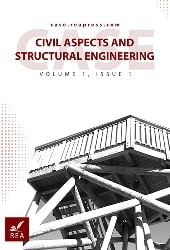Investigation and Comparison of Properties of Fresh and Hardened Concrete Containing Industrial and Waste Steel Fibers
Abstract
Concrete is the second most widely used material in the world, and since concrete is inherently brittle and fragile, it has little resistance to impact and intermittent loads. Due to its brittleness, hardened concrete has low tensile strength and low ultimate strain capacity. For this reason, necessary measures must be taken to overcome this limitation. Random dispersion of fibers in concrete has been proposed as an effective and economical solution for reducing fatigue loads and static force transmission by improving the mechanical properties of concrete. Fibers are used to control and prevent the formation of microcracks that occur due to volume changes caused by shrinkage and thermal stresses, and increase the tensile, flexural, compressive strength, energy absorption capacity, and brittleness of concrete. In this study, the behavior of concrete under the influence of two types of industrial and waste steel fibers was investigated at ages of 7, 14, and 45 days in both dry and wet states, and concrete samples were subjected to compressive, tensile, and water absorption tests. The samples were obtained from a mixing design, in which sample A was used as a control sample without fibers, and samples B1 and B2 were added with 1% by volume of industrial steel fibers and once with waste steel fibers. As concrete ages, tensile and compressive strengths have increased in both regular and fiber-reinforced concrete. In addition, the results of the test showed that the use of steel fibers in concrete increases tensile and compressive strengths. By examining the increase in tensile and compressive strength in concrete containing industrial and waste steel fibers, it was observed that the use of industrial steel fibers has a greater effect on increasing the tensile and compressive strengths of concrete. By examining and comparing the samples in both dry and wet states, it was observed that, in general, samples containing fibers in the wet state have higher mechanical properties than samples in the dry state. Next, to examine the amount of water absorption, we first dried the samples in an oven and then immersed these samples, which were 7, 14, and 45 days old, in water. By examining the amount of water absorption, it was observed that the samples without fibers had less water absorption than the samples with fibers
Keywords:
Concrete, Compressive strength, Tensile strength, Industrial steel fibers, Waste steel fibersReferences
- [1] Moghadam, A. S., Omidinasab, F., & Abdalikia, M. (2021). The effect of initial strength of concrete wastes on the fresh and hardened properties of recycled concrete reinforced with recycled steel fibers. Construction and building materials, 300, 124284. https://doi.org/10.1016/j.conbuildmat.2021.124284
- [2] Afroughsabet, V., & Ozbakkaloglu, T. (2015). Mechanical and durability properties of high-strength concrete containing steel and polypropylene fibers. Construction and building materials, 94, 73–82. https://doi.org/10.1016/j.conbuildmat.2015.06.051
- [3] Domski, J., Katzer, J., Zakrzewski, M., & Ponikiewski, T. (2017). Comparison of the mechanical characteristics of engineered and waste steel fiber used as reinforcement for concrete. Journal of cleaner production, 158, 18–28. https://doi.org/10.1016/j.jclepro.2017.04.165
- [4] Larner, L. J., Speakman, K., & Majumdar, A. J. (1976). Chemical interactions between glass fibres and cement. Journal of non-crystalline solids, 20(1), 43–74. https://doi.org/10.1016/0022-3093(76)90107-1%0A
- [5] Walton, P. L., & Majumdar, A. J. (1975). Cement-based composites with mixtures of different types of fibres. Composites, 6(5), 209–216. https://doi.org/10.1016/0010-4361(75)90416-4
- [6] Bencardino, F., Rizzuti, L., Spadea, G., & Swamy, R. N. (2010). Experimental evaluation of fiber reinforced concrete fracture properties. Composites part b: engineering, 41(1), 17–24. https://doi.org/10.1016/j.compositesb.2009.09.002
- [7] Yoon, Y. S., Yang, J. M., Lee, J. H., & Lee, S. H. (2011). Structural enhancement of high-performance concrete members by strategic utilization of steel fibers [presentation]. The 9th international symposium on high performance concrete-design, verification & utilization, rotorua, new zealand.
- [8] Nili, M., & Afroughsabet, V. (2010). Combined effect of silica fume and steel fibers on the impact resistance and mechanical properties of concrete. International journal of impact engineering, 37(8), 879–886. https://doi.org/10.1016/j.ijimpeng.2010.03.004
- [9] Libre, N. A., Shekarchi, M., Mahoutian, M., & Soroushian, P. (2011). Mechanical properties of hybrid fiber reinforced lightweight aggregate concrete made with natural pumice. Construction and building materials, 25(5), 2458–2464. https://doi.org/10.1016/j.conbuildmat.2010.11.058
- [10] Bentur, A., Mindess, S., & others. (2006). Fibre reinforced cementitious composites. CRC press.
- [11] Feldman, D., & Zheng, Z. (1993). Synthetic fibres for fibre concrete composites. MRS online proceedings library (opl), 305, 123.
- [12] Banthia, N., Moncef, A., Chokri, K., & Sheng, J. (1995). Uniaxial tensile response of microfibre reinforced cement composites. Materials and structures, 28(9), 507–517. https://doi.org/10.1007/BF02473155


